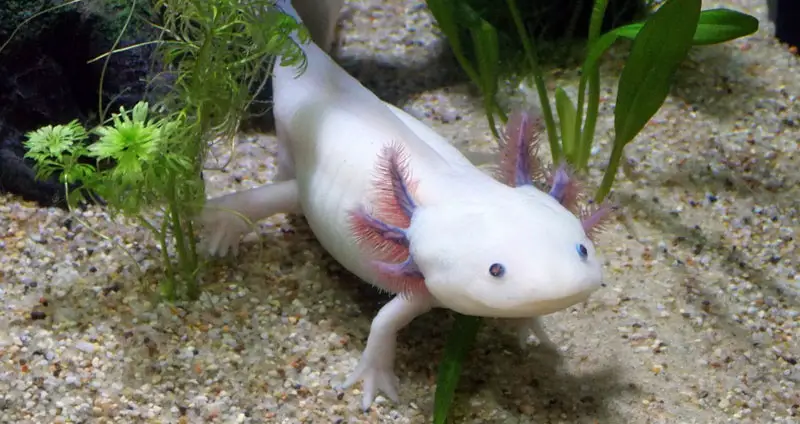Axolotl are some of the most unique and interesting pets that you can possibly own. These creatures were nearly extinct at one time, but have bounced back and become a popular pet for aquarium enthusiasts.
Many people have seen normal type axolotl, and a few have likely seen albino axolotl. However, few people are aware of just how many different axolotl colors actually exist!
This post will highlight 14 axolotl colors, or morphs, to help you get a better understanding of just how diverse these interesting little creatures can be.
Table of Contents
How Do Axolotl Get Their Colors?
The coloration of axolotl can get quite complex, so we’ll try to simplify things. Axolotl color is determined by pigment cells in their skin called chromatophores.
There are several different kinds of chromatophores that axolotl can possess, and they have a big impact on the axolotl’s physical appearance.
- Melanophores – Contains a black-brown pigment called eumelanin
- Xanthophores – Contains yellow and red pigments called carotenoids and pteridines
- Iridophores – Shiny iridescence caused by crystallized purines
Each of the above cells in an axolotl has 14 pairs of chromosomes, and it’s in these chromosomes that the axolotl’s characteristics are determined.
These genes are inherited independently from each other, so a pair of genes will come together into an allele and code for the same physical characteristic — in this case pigment. Each parent will contribute a gene for that pigment.
These alleles will then determine what physical appearances are present in an axolotl depending on which gene is dominant and which is recessive!
While basic genetics plays a big role in coloring axolotl, mutations also play a role! An axolotl may be genetically designed to be one way, but their DNA may mutate slightly to give them a slightly different appearance.
Whether it be increased iridophores or decreased melanophores, these mutations can create very unique-looking axolotl.
What Are The Different Axolotl Colors?
As of now, there are many different axolotl morphs that result in hundreds of different colors and color combinations. This post will highlight 14 axolotl morphs, including some common and extremely rare colors that exist today or have existed in the past.
Please note that the prices listed in this chart are simply estimates. Most of the axolotl morphs sell for the price ranges listed, but there are definitely outliers.
Additionally, some axolotl are so rare that they’re never actually sold, resulting in their price being incalculable!
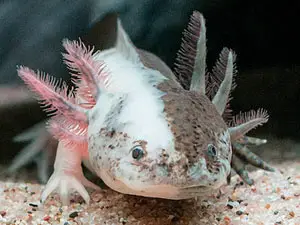
Chimera Axolotl
Caused by the rare fusing of two eggs, one side of this axolotl is from one egg while the other side is from another. Coloration is split right down the middle, and survival rates are very low.
Price
$???
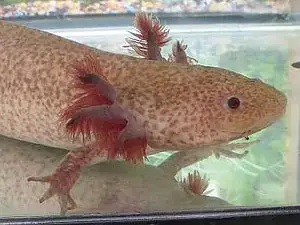
Copper Axolotl
This is a special type of albino axolotl that exists primarily in the US, Australia, and Germany. They’re copper colored and may have dark spots but entirely lack black pigment.
Price
$60 – $70
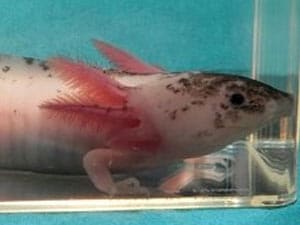
Dirty Leucistic Axolotl
A variation of the leucistic axolotl. This name is reserved for leucistic axolotl that have black spots on their head and back. These spots are used as camouflage and can disappear over time.
Price
$40 – $50
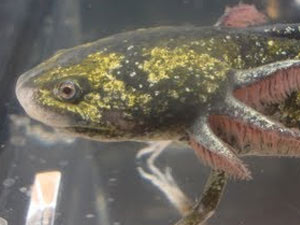
Enigma Axolotl
Essentially, this axolotl morph is a normal type with unique coloring through sparkly iridophores. This coloring is rare and random, but has been seen in several different axolotl.
Price
$???
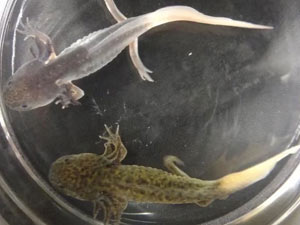
Firefly Axolotl
These are man-made axolotl created by Lloyd Strohl II through embryonic graphing. Dark firefly axolotl have light tales, and vise-vera for light axolotl. Less than a dozen have ever existed.
Price
$???
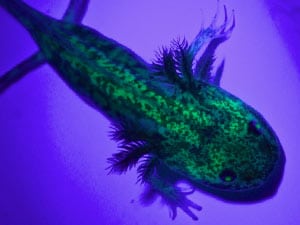
GFP Axolotl
These axolotl are created from a protein in their genomes called Green Fluorescent Protein. This protein glows a vibrant green under UV or black lights and can be combined with all other morphs.
Price
$40 – $50
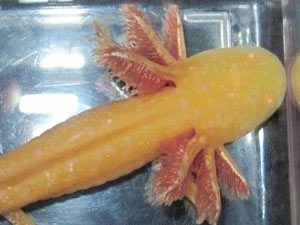
Golden Axolotl
An albino morph with a body that’s colored goldish-yellow. Gill colors vary from red to pink to yellow, and eyes can be red or transparent. They also have random iridophores over their bodies.
Price
$40 – $50
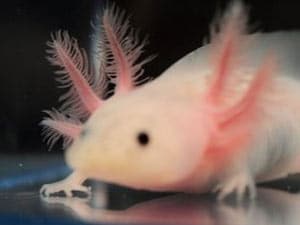
Leucistic Axolotl
Very similar axolotl to albinos, with the main distinction being its dark-colored eyes. Leucistic bodies are white-colored with light pink gills. This coloration has made them extremely popular.
Price
$30 – $40
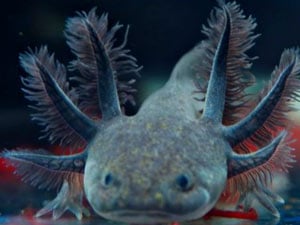
Melanoid Axolotl
While melanoid axolotl are very similar to wild types, they have a higher quantity of melanophores which makes them black. It also lacks shiny pigments that other axolotl have.
Price
$40 – $50
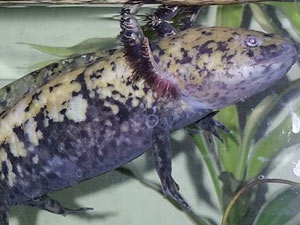
Mosaic Axolotl
Similar to the chimera axolotl, mosaics are the result of cells combining early on. However, the difference is that each cell displays phenotypes of both cells. This is a totally random occurrence.
Price
$30 – $40
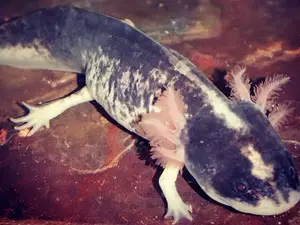
Piebald Axolotl
Similar to dirty leucistic axolotl, piebalds have black markings. However, piebalds have more prominent black pigmentation all over their body — not just on their head.
Price
$50 – $100
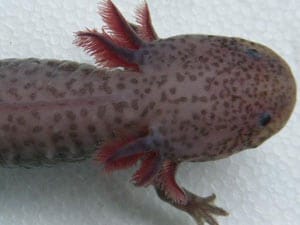
Silver Dalmatian Axolotl
An extremely rare morph that gives an axolotl a lavender coloration. It also has spots all over its body that resemble a dalmatian, hence the fitting name.
Price
$???
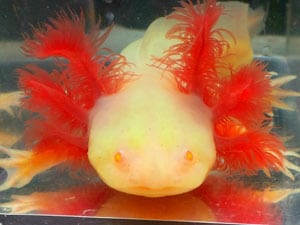
White Albino Axolotl
An axolotl morph that’s quite similar to leucistics. The main difference between the two is that white albinos have clear or red eyes, while leucistics have black eyes.
Price
$30 – $40
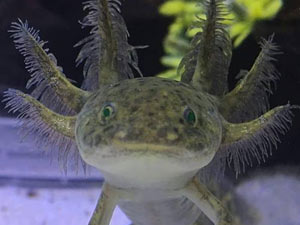
Wild Type Axolotl
These are the axolotl commonly found in nature. It’s a dark green/brown/black color with gold specks over its body. Wild types turn darker as they age, approaching melanoid darkness.
Price
$20 – $40
Most Desired Axolotl Colors
While every single axolotl color is bound to attract a good portion of people, there are some colors that stand out from all the others.
Whether it be due to the rarity of the morph or the simple beauty of it, the colors below tend to fetch a substantially higher price than wild type axolotl.
Combinations of morphs resulting in a mashing of different colors usually results in the most expensive specimens.
- Chimera Axolotl – This is a realistically-attainable axolotl that most people still won’t be able to get their hands on. Because of the fact that it’s created due to a random combining of egg cells, this appearance is not replicable on purpose. So, when a chimera axolotl is born, it’s nothing short of a miracle. The predicted probability of a chimera axolotl being born and surviving is extremely small, meaning that these axolotl can fetch a very large amount of money because of their dual color scheme.
- Enigma Axolotl – It may seem like the enigma axolotl is a unique morph, but that doesn’t appear to be the case. Many axolotl experts suggest that this is a wild type axolotl with extremely unique coloration and patterns that differentiate it greatly. This styling isn’t able to reliably get passed between generations, so occurrences of this morph will sell for a lot of money if their owners are willing to part with them.
- Firefly Axolotl – Since these axolotl were created in a lab by one man, that technically makes these the rarest and most coveted axolotl in existence. It’s likely possible to recreate the work that was done to achieve this coloration, but nobody has even attempted to do so. Therefore, firefly axolotl will always have their place in history, with many people dreaming of the day that they’d be able to get their hands on one.
Regular vs. Uniquely-Colored Axolotl Costs
While all axolotl, regardless of their morph, act the exact same and have the same care requirements, its their unique colors that add so much value. Enthusiasts will be willing to spend hundreds or even thousands on an axolotl that looks like no other axolotl has ever looked or will ever look.
It’s very common to find a wild type axolotl for sale for around $30, with some even selling for $20. However, you’re not going to get much cheaper than that. Once you start adding new colors, prices can start to increase substantially.
For example, a melanoid axolotl with more black pigment than a wild type is worth about double, and so is an axolotl with GFP.
Where the really high prices come from, though, is when different morphs are combined into one axolotl. This creates very unique appearances that people are willing to pay a high price for.
For example, fully-grown GFP / wild type / melanoid / mosaic axolotl can sell for more than $300! Combinations are virtually endless, so there’s a broad range of prices for these incredibly unique axolotl.

